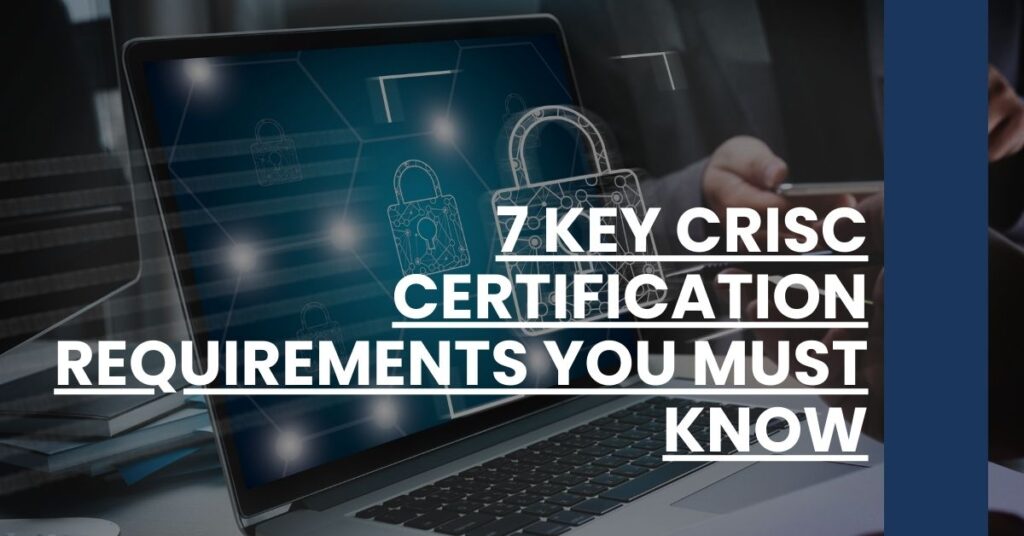Are you navigating the complexities of IT risk management and aiming for a CRISC certification?
With the right guidance, meeting the CRISC certification requirements need not be daunting.
This article zooms in on the essential qualifications you’ll need — from professional experience to exam preparation — mapping out a clear route to enhance your credentials and secure your position as an enterprise risk management expert.
- 1. Understanding the CRISC Certification
- 2. Educational Background Necessary for CRISC
- 3. Professional Experience Prerequisites
- 4. Exam Eligibility Criteria
- 5. The CRISC Examination Explained
- 6. Continuing Education and Maintenance Requirements
- 7. Code of Professional Ethics and Standards
- Incorporating Industry Experience for Eligibility
- Pathways for Non-Traditional Backgrounds
- Dealing with the Financial Aspect of CRISC Certification
- Conclusion: Launching Your Risk Management Career with CRISC
1. Understanding the CRISC Certification
When you’re looking to solidify your presence in the IT risk management landscape, the CRISC certification stands as a towering beacon of expertise. But what does it really take to etch your name on this badge of honor? Certified in Risk and Information Systems Control, better known as CRISC, is a designation awarded by ISACA, a global association that helps business technology professionals realize the positive potential of technology. This certification is not just an acronym to add to your email signature; it’s a passport to a new world of credibility, career opportunities, and a unified language with stakeholders in the IT security domain.
- Professional Prestige: Holding a CRISC title tells the world you have the knowledge and proficiency to identify and manage enterprise IT risk and implement and maintain information systems controls.
- Career Advancement: Equipping yourself with CRISC certification can set you up for higher roles within your organization and make you a sought-after professional within the industry.
Understanding CRISC certification requirements isn’t just about ticking off a checklist. It’s a commitment to upholding excellence and a pledge to continuous learning in the fast-evolving realm of IT risk management. The question isn’t just ‘are you ready to take on the CRISC?’—it’s also ‘how far are you willing to go for your professional growth?’
2. Educational Background Necessary for CRISC
Navigating the seas of CRISC certification requirements begins with your educational foundation. While ISACA does not prescribe a strict educational path to certification, it’s implied that a strong foothold in IT or business is a significant advantage. Your academic background frames your understanding of the complex world these domains interact in.
Considering the depth and breadth of knowledge required to excel in IT risk management, a degree in fields such as computer science, information systems, cybersecurity, or business administration stands as a strong precursor to your certification journey. Your education is the soil from which your career grows, and CRISC acts as the sunlight helping you reach new heights in the professional ecosystem.
3. Professional Experience Prerequisites
Your journey toward CRISC certification is anchored by real-world experience. ISACA mandates a minimum of three years of hands-on involvement in at least two of the four CRISC domains. Let’s parse through what this means for your professional path:
- Practice Makes Perfect: Substantive experience is key to ensuring that you’re not just book-smart but also have the practical skills to back up your theoretical knowledge.
- Diverse Expertise: Being proficient in multiple CRISC domains signifies a holistic understanding of risk management, setting you apart as a well-rounded professional.
This requirement embodies the old adage “there’s no substitute for experience”—it’s the medium through which you apply your learned principles and sharpen your ability to navigate the complex world of IT risk and control.
4. Exam Eligibility Criteria
To sit for the CRISC exam, you don’t need to scale a wall of prerequisites. The path is exact yet attainable:
- Accept the Challenge: Enroll for the exam, which entails meeting the prescribed work experience.
- Stay Updated: Your efforts in passing the CRISC exam must be within the last five years—this ensures that your knowledge remains current and relevant.
The CRISC certification journey is about committing to your professional growth and showing readiness to tackle the challenges of IT risk management head-on.
5. The CRISC Examination Explained
Conquering the CRISC exam is a cornerstone of the certification process. Here’s a detailed dive into what the exam entails and how you can prepare for this crucial step:
- Exam Breakdown: The exam is a rigorous 150-question marathon, covering four primary domains: Risk Identification, Assessment, Response and Mitigation, and Control Monitoring and Reporting. Designed to gauge your mastery in each area, the test comprises a variety of question types to challenge your analytical and application skills.
- Focused Domains: Each domain occupies a specific percentage of the exam, reflecting its relative importance and application in the field. For example, Risk Identification encompasses 27% of the exam content, ensuring a comprehensive evaluation of your capabilities.
Preparing for the CRISC exam is about more than just memorizing facts and figures—it’s an intricate dance of understanding theories, applying them to real-world scenarios, and continuously adapting your knowledge to meet ever-evolving technological risks. Your success in the CRISC examination hinges on your ability to think critically and apply your insight to protect and enhance the strategic objectives of your organization.
6. Continuing Education and Maintenance Requirements
The journey to achieving CRISC certification is akin to running a marathon, and just like any long-distance race, it demands not only a strong start but consistent pace and endurance. This is where continuing education and maintenance requirements come into play. As a CRISC-certified professional, you have proven your expertise. Maintaining that standard ensures that you remain at the top of your game, delivering value to your organization and the broader industry.
- Commit to Being Evergreen: Like technology itself, knowledge in IT risk management constantly evolves. Staying updated is not just a requirement but a professional duty. The requirement of a minimum of 20 CPE hours annually is your commitment to lifelong learning, ensuring that your skills never go obsolete.
- Spread Your CPE Investments: Over a rolling three-year period, you’ll need an impressive portfolio of 120 CPE hours. Diversifying your professional development across various educational activities not only satisfies these requirements but enriches your expertise from multiple angles.
Fulfilling these requirements acts as a steady pulse, ensuring that the blood of newfound knowledge and competencies circulates through your professional veins, keeping you vibrant and relevant in a field that demands nothing short of excellence.
7. Code of Professional Ethics and Standards
While technical skills are the loudspeakers of your professional persona, ethics and standards are the quiet, yet unwavering, backbone that upholds your reputation. The CRISC Code of Professional Ethics demands a level of conduct that exemplifies integrity, objectivity, and professionalism. Let’s reflect on what this credo means:
- Integrity: Stand as a beacon of reliability and accountability in your risk management practices.
- Confidentiality: Guard your client’s sensitive data with vigilance akin to a sentinel at the gates.
- Professional Competence: Strive for the zenith of excellence and effectiveness in all professional tasks you undertake.
Embracing these values is not only intrinsic to the CRISC certification requirements but is the hallmark of a true leader in the IT risk management space.
Incorporating Industry Experience for Eligibility
When charting your trajectory towards meeting the CRISC certification requirements, nothing adds more substance than rich industry experience. Your days in the trenches, dealing with real-life IT risks, flesh out the framework that the CRISC certification provides, transforming concepts into powerful, actionable instincts. The journey towards CRISC eligibility calls for:
- Versatility: Ensure that your experience spans various roles, reflecting a robust adaptability to different risk scenarios.
- Relevance: Focus on accumulating experiences that align directly with the CRISC domains of practice, ensuring every day counts towards your eligibility.
This groundwork of professional experience solidifies your candidacy for CRISC, proving you’re not only educated in principles of IT risk management but also battle-tested in its application.
Pathways for Non-Traditional Backgrounds
For those who may not have embarked on a conventional IT risk management career path, the CRISC certification requirements do not gate off opportunities. Indeed, professionals with non-traditional backgrounds bring unique perspectives that enrich the field. The prerequisites remain steadfast—a passing score on the CRISC exam and the requisite work experience—but the journey there can be as varied as the individuals undertaking it.
- Leverage Transferable Skills: Are you coming from a different but related field? Shine a light on the skills that crossover to IT risk management.
- Navigate Thoughtfully: Chart a course through roles that build on each domain required for certification, ensuring they converge at the nexus of CRISC eligibility.
Every professional’s route may be peppered with different milestones, but the destination remains the same—an elite community of professionals equipped with the tools and insights to manage and mitigate IT risk.
Dealing with the Financial Aspect of CRISC Certification
An investment in your career often comes with a financial consideration, and the CRISC certification is no exception. The costs involved in obtaining and maintaining your certification might seem like a tall order, but when measured against the amplified earning potential and career advancement it offers, the scales tip favorably towards viewing it as a wise investment in your future.
- Examination Fee: The outlay for the CRISC exam is a step that gates your entry into the realm of certified professionals, with fees allotted at $575 for ISACA members and $760 for non-members.
- Maintenance Fee: Embrace the annual maintenance fee as your subscription to a catalog of growing knowledge and an expanding network, priced at $45 for members and $85 for non-members.
While the initial and recurring fees are considerations to plan for, they pale in comparison to the wealth of opportunities and career growth that come with being CRISC-certified.
Conclusion: Launching Your Risk Management Career with CRISC
To propel your career in the stratosphere of IT risk management, the CRISC certification is a potent fuel. It’s a testament to your dedication and proof of your expertise, opening up opportunities far beyond the horizon. Understanding and meeting the CRISC certification requirements is a mission that calls for foresight, preparation, and a relentless pursuit of excellence.
From the foundational necessity of acquiring relevant industry experience to navigating the financial aspects of certification, each step is a building block towards not just a title, but a burgeoning career that’s impactful and fulfilling. As you embark on this transformative voyage, remember that CRISC isn’t just a certification—it’s your ticket to becoming an indispensable asset in the realm of risk management.

